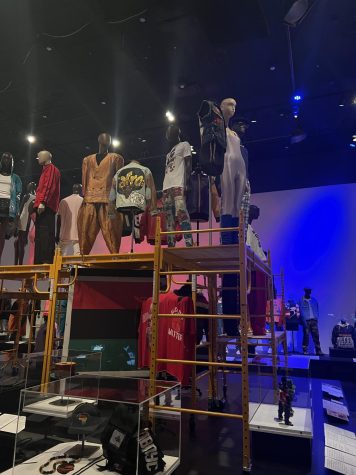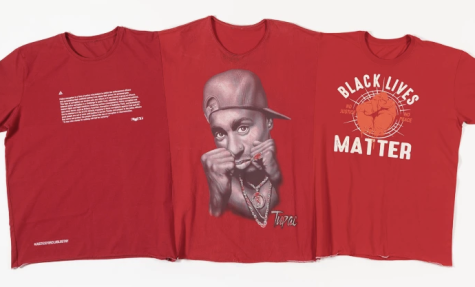Hip-hop music embraces artistic elements while simultaneously transcending lyrics into venues of understanding, confronting, and commenting on life’s beauty and faults. Hip-hop is not just a genre of music, but a culture, according to The New York Times. A museum exhibition at The Museum of the Fashion Institute of Technology (FIT) kicks off the celebration of the fiftieth anniversary of hip-hop, displaying the music and style that resided in the Bronx, New York, and conquered the world.
Mr. Clive Campbell’s (DJ Kool Herc) legendary back-to-school party in the Bronx, New York August 11, 1973, marked the beginning of music and style that would eventually consume modern-day culture, according to theguardian.com. The music genre began with diverse groups of Black, Latinx, and Caribbean-American youth gathering in an impoverished community, according to The New York Times. While the beats of hip-hop’s founders echoed down the streets of New York in the 1970s, the tunes continue to amuse a global concert 50 years later.

DJ Kool Herc’s party sketched the foundation of hip-hop culture, and his impact on the music industry remains prevalent in modern-day music. In contrast to then-popular disco and rhythm and blues (R&B) hits, DJ Kool Herc’s apartment shook with soul and funk tunes, according to pastemagazine.com. His “fresh” music style broke boundaries in the music industry and racial injustice, linking diverse cultures through the arts.
Generations have attacked, stereotyped, and oversimplified hip-hop, restricting communities of expression and celebration of the arts. Hip-hop includes elements of aspiration, creativity, customization, and individualization in their music and fashion trends. However, critics interpret the genre and style as “too much,” according to theguardian.com. Ultimately, breaking boundaries is a fundamental component of hip-hop, which mainstream culture would inevitably adopt and appropriate.
Located in Chelsea, New York City, “Fresh, Fly, and Fabulous: Fifty Years of Hip Hop Style” is a free exhibition open to the public. The exhibition celebrates the birth of hip-hop and its influence on fashion over the past five decades. With over 100 garments and accessories, it’s the largest and most comprehensive exhibition to explore this influential style.
Mrs. Elena Romero, author and advertising communications professor at FIT, and Ms. Elizabeth Way, author and associate curator of costume at FIT, collaborated to curate the exhibition “Fresh, Fly, and Fabulous: Fifty Years of Hip Hop Style,” according to fitnyc.edu. The Museum at FIT’s exhibition unveils many themes in hip-hop history, exploring early immersion in the Black Lives Matter movement, culture shifts, luxury, and designer influence. The museum depicts the rise of celebrities in the fashion industry and its progressive growth as an international phenomenon, according to fitnyc.edu.

Authors Ms. Way and Mrs. Romero also poured their fashion expertise and love for hip-hop into their book, Fresh Fly Fabulous: 50 Years of Hip-Hop Style, according to rollingstone.com. In an interview with Ms. Way and Mrs. Romero, Rolling Stone leads a discussion addressing the curators’ motives behind the exhibition.
“What this exhibit hopes to accomplish is to show the public the wide variety of styles that incorporate what it is to be part of hip-hop culture,” Mrs. Romero said, according to rollingstone.com.
Each article of clothing along the exhibition’s isles narrates an eclectic story that 50 years of hip-hop culture recounts. Fusing together modern-day culture with old-school hip-hop, designer Mr. Paul McCall’s “Triple T-shirt” draws attention to Black pride and hip-hop’s verbal dominion of protest. The artist illustrated Mr. Tupac Skahur’s (Tupac) portrait with Black Lives Matter imagery accompanying text concerning police corruption. This avant-garde “Triple T-shirt” poignantly illustrates Tupac’s monumental influence in fighting racism.
Tupac has sold 75 million albums to date, making him one of the top-selling artists of all time, according to biography.com. Not only was Tupac a successful rapper, but he was also a socially-conscious artist who painted his music with lyrical critiques of sexism and racism. Tupac brought a level of rawness and poetic drive in how he delivered his words, according to rollingstone.com. The rapper’s self-empowerment drove individuals to want to listen to what he had to say. The hip-hop icon’s mother, Ms. Afeni Shakur Davis, sparked Tupac’s immersion in progressive movements, according to nbcnews.com.

Even though Tupac introduced most of his fans to Ms. Davis through his 1995 hit “Dear Mama,” her fellow Black Panthers and those she advocated for in her days recognize her for much more. The Black Panther Party was a group that aimed to patrol Black neighborhoods to protect residents from police brutality, according to britannica.com. Ms. Davis’ involvement with Black pride inspired her son’s lyrical conquests, causing Tupac’s legacy to extend today to political movements like Black Lives Matter.
Given the current need for outspokenness, justice, and engagement, the value of hip-hop remains prominent today. Accepting the baton from old-school rapper Tupac, rappers like Mr. Kendrick Lamar continue to preach to today’s generation of Black youth with optimistic and hopeful lyrics. Thus, hip-hop culture continues to connect youth with powerful visions of social awareness, identity, and purpose.
Parallel to Mr. McCall’s unconventional “Triple T-shirt” sartorial design, Tupac entwines racial inequality with art, unveiling the link between passion and its influence. While both artists allude to art’s ability to forge a difference in the world, artists like Mr. McCall and Tupac leave imprints behind for generations to come.
“I’m not saying I’m gonna change the world, but I guarantee that I will spark the brain that will change the world,” Tupac said, according to goodreads.com.
Featured Image by Ana Patricio ’24




